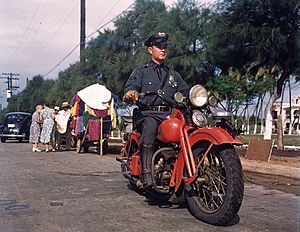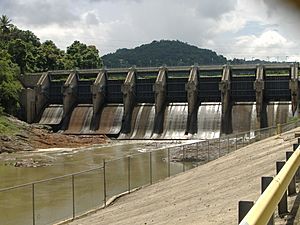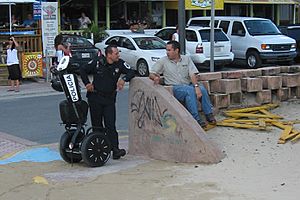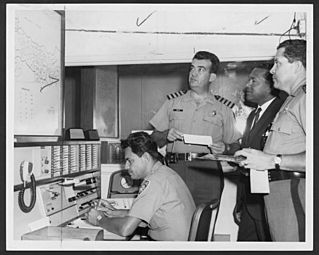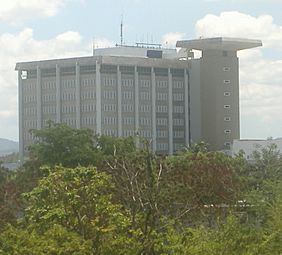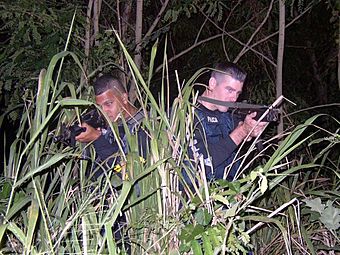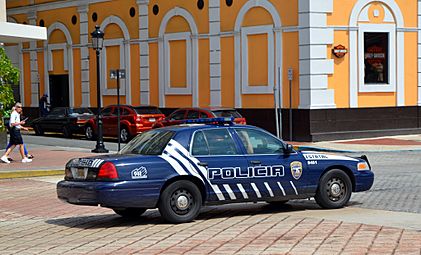Puerto Rico Police facts for kids
Quick facts for kids Puerto Rico Police Bureau |
|
|---|---|
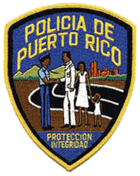
Patch of the Puerto Rico Police Bureau
|
|
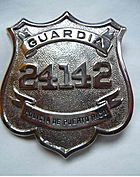
Badge of the Puerto Rico Police Bureau
|
|
| Common name | La Uniformada (The Uniformed) |
| Abbreviation | PRPB |
| Motto | Integrity and Protection |
| Agency overview | |
| Formed | February 21, 1899 |
| Preceding agency |
|
| Dissolved | 1899–1956 |
| Jurisdictional structure | |
| Operations jurisdiction | Puerto Rico |
| Size | 5,324 square miles (13,790 km2) |
| Population | 3,195,153 (2018 estimate) |
| Legal jurisdiction | Commonwealth of Puerto Rico |
| General nature | |
| Operational structure | |
| Headquarters | Cuartel General, 601 Ave. Roosevelt, Hato Rey San Juan, PR 00936-8166 |
| Police Officers | 10,200 (2023 estimate) |
| Agency executive |
|
| Parent agency | Department of Public Safety |
| Child agency |
|
| Supervisions |
List
Field Operations
Management Services Professional Responsibilities Community Relations Strategy Operations Administrative Services United Forces of Fast Action (F.U.R.A.) Criminal Investigations Corps Highway Patrol Drugs and Illegal Weapons |
| Regions |
List
San Juan
Bayamón Ponce Carolina Fajardo Arecibo Aguadilla Caguas Humacao Mayagüez Aibonito Guayama Utuado |
| Facilities | |
| Districts and Precincts | 71 Districts (One station in town) 34 Precincts (more than 1 station in town) 13 Highway Patrol Areas |
| Police cars & Motorcycles | Ford Crown Victoria Police Interceptor Ford Explorer Ford Taurus Ford Econoline Ford F-250 Chevrolet Trailblazer Chevrolet Tahoe Chevrolet Impala Dodge Charger Harley Davidson Electra Glide Honda Shadow Suzuki Intruder |
| Aircraft | Bell 407 Bell 412 McDonnell Douglas MD-520N Cessna 404 Titan Cessna 310R |
| Website | |
| policia.pr.gov | |
The Puerto Rico Police (Spanish: Policía de Puerto Rico), officially the Puerto Rico Police Bureau, is a law enforcement agency with jurisdiction over the entire Commonwealth of Puerto Rico. It is a division of the Puerto Rico Department of Public Safety (PR DPS), alongside the Puerto Rico Special Investigations Bureau and the Puerto Rico Municipal Police and handles both traffic and criminal law enforcement in the commonwealth. As of 2020, the Puerto Rico Police force had 11,532 members. It is organized into thirteen regions within the island for operational purposes. Its headquarters are located at 601 Franklin D. Roosevelt Avenue in San Juan.
Contents
History
Origins
The first form of the Puerto Rico Police began in 1837, when Spanish governor Francisco Javier de Moreda y Prieto created La Guardia Civil de Puerto Rico (Puerto Rico Civil Guard) to protect the lives and property of Puerto Ricans, who at the time were Spanish subjects. It provided police services to the entire island, although many municipalities maintained their own police force.
Since taking possession of Puerto Rico in July 1898, as a result of the Spanish–American War, the United States has controlled the island as a US territory. The Insular Police of Puerto Rico was created on February 21, 1899, under the command of Colonel Frank Techner (US Marine officer during the Spanish–American War), with an authorized strength of 313 sworn officers.
Ponce massacre
On March 21 of 1937, approximately 30 officers placed themselves in an intersection in downtown Ponce to block a march by the Puerto Rican Nationalist Party to celebrate the abolition of slavery and protest the incarceration of Pedro Albizu Campos. As the demonstrators marched, singing La Borinqueña (Puerto Rico's national anthem), General Blanton Winship, the U.S. appointed governor of Puerto Rico, ordered Chief of Police Guillermo Soldevilla to open fire on the protesters. The massacre lasted 15 minutes and resulted in 19 fatalities. This and other incidents involving the Insular Police fueled the Puerto Rico independence movement, leading to the burning of police stations and post offices in 1950, and the Jayuya Uprising.
Quasi-military
In 1980, in accordance with Law 26 of 1974, it was described as "a quasi-military" organization of public safety, later to be changed by the "Puerto Rico Police Act" (Act No. 53) of 10 June 1996 as a "Civil Organization" of public safety as those on the US mainland.
In 1993, governor Pedro Rosselló created a new plan to fight back against crime called Mano Dura Contra el Crimen (or "Strong Hand Against Crime") in which Puerto Rico Police officers were assisted by the Puerto Rico National Guard in everything that involved police work, except police investigations. They were better known because of the raids that they made in public housing complexes or "Caseríos" with rapid force and precision and also, the use of military vehicles and tactics. This program was put to the test from 1993 to 1996 and in total 48 police officers died in the line of duty. It was later activated again in 2004 by the governor Sila María Calderón but not with the same intensity as in the early 1990s.
Reorganization
In 2009, Police Superintendent José Figueroa Sancha reorganized the Puerto Rico Police in terms of commanding officers and regional organization. Every police zone was changed to have two commanding officers: one in charge of the field operations, and the other in charge of investigations. The name was changed from Police Zones to Police Regions. Also, a new policy of the agency was to get involved in the community. Officers must get out of their patrol cars and sometimes patrol on foot in neighborhoods, so they can talk to citizens and socialize, as well as identify the problems that exist in the neighborhood.
In 2017, Ricardo Rosselló, Governor of Puerto Rico, created the Public Security Department with Héctor Pesquera as its head which combined various government agencies under the control of a larger umbrella agency.
Financial problems
The economic crisis on the island and the budget of the island is currently under control of the Financial Oversight and Management Board for Puerto Rico created financial difficulties for the force. In 2019, the PRPD has dropped to 6,450 officers. The police force lost significant amounts of members as a result of officers retiring and reduced funding for recruitment. Estimates from 2018 suggested the force needed over a thousand more officers to meet the needs of the island. Representatives and senators proposed increase in the wages of the force to help increase recruitment. The lack of members affected the strength of the force and response to preventing crimes across the island.
Rank structure
| Rank | Comisario Commissioner |
Coronel Colonel |
Teniente Coronel Lieutenant Colonel |
Comandante Commander |
Inspector Inspector |
Capitán Captain |
Teniente Primero First lieutenant |
Teniente Segundo Second lieutenant |
Sargento Sergeant |
Agente Officer/ Agent |
Cadete Cadet |
|---|---|---|---|---|---|---|---|---|---|---|---|
| Insignia |  |
 |
No insignia | ||||||||
| Description | Governor Appointee | Bureau/ Regional/ Administrative Commander | Regional/ Administrative Commander | Regional Commander | Division/ Unit/ District Commander | District/ Precinct/ Unit Commander/Supervisor | District/ Precinct/ Unit Commander | District/ Precinct Commander | Shift Supervisor | Patrol |
The Commissioner is the top commanding officer. He is one of five "head of government agencies" appointed by the Governor of Puerto Rico under the Department of Public Safety. He leads the department and makes orders to the agency, and also instructs the commanding officers for field operations.
Since 1899, police chiefs in Puerto Rico were appointed by the United States Government. Selecting the police chief was originally the responsibility of the commanding officer of the United States Army in Puerto Rico, who also served as the governor until 1900 when the Foraker Act was established. Afterward, police chiefs were named by the U.S. Appointed Governor of Puerto Rico and the Chief of Police could serve in that position for not more than 4 years.
Law #77 converted the Puerto Rico Insular Police into the Puerto Rico Police Department on June 22, 1956. This converted the department from a quasi-military organization into a civil police force. The Chief of Police position was replaced by a Superintendent. Since then, the police superintendent has been named by the Governor of Puerto Rico.
The Associate Superintendent is the second in command. He follows every order from the commissioner, including if the commissioner cannot do some specific things that the second in command can do. Also, in case of sickness, disability or death, the Associate Superintendent assumes the position of Commissioner.
The Auxiliary Superintendent of Field Operations is in charge of every activity in the Puerto Rico Police Department that is related to the protection of life and property, maintaining law and order, the protection of civil rights, and crime prevention, almost as a 2nd in command. He plans, coordinates, leads, and controls all the operational actions in the prevention service phase with the integration of citizens in a common effort and meet the training-educational aspect of children and to prevent youth crime, in line with guidelines issued by the Superintendent.
Divisions and bureaus
- Highway Patrol Bureau
- Joint Forces of Rapid Action
- Motorized Impact Unit
- Robbery and Bank Fraud Division
- Security and Protection Office
- Special Arrest and Extraditions Division
- Tactical Operations Division
Resources
Air support
The Aerial Services of the Puerto Rico Police Department are operated by F.U.R.A. known in Spanish as Fuerzas Unidas de Rapida Accion (Joint Forces of Rapid Action). It also provides air support to the ground units.
The aerial services unit dates back to 1963, when the air unit was stationed at Isla Grande Airport. Its fleet at that time consisted of Fairchild Hiller FH-1100 and OH-23 Raven helicopters.
In 1986, the unit was integrated to form the FURA. The fleet was changed to MBB/Kawasaki BK 117, MD 500 and Bell 206 helicopters. The BK117s were "state of the art" in equipment for police patrol missions; one of the helicopters had weather radar and full IFR capability. The Puerto Rico police became one of the first air units in the U.S. to operate a large BK117 fleet on police missions. The BK117 helicopters are no longer in use, and most were auctioned off in recent years.
On December 31, 1986, a fire occurred at the Dupont Plaza Hotel. People fled to the roof of the hotel to escape the fire, which had started in the hotel's casino. The PR Police air unit responded with the MD 500 series helicopter, unit N5231G. Lt. Julio Colón, the pilot, landed the helicopter on the roof of the 17-floor hotel, with just one skid in contact. Space limitations of the roof structure prevented a more stable contact with both skids.
In the mid-1990s, the air unit received one MD 520N NOTAR system, tail number N128PD, and one Beechcraft Super King Air. This aircraft has the same equipment as United States Customs Service aircraft. Today, the King Air is "not airworthy".
On July 26, 1993, MD Helicopters MD 500 N126PD "S/N 0499E", was on patrol when it collided with a cable wire with fatal consequences. The accident occurred when the helicopter struck a high-voltage wire, not having reached the necessary height to avoid hitting them. The helicopter caught fire instantly and the remains landed near some gates of Carraízo Dam in Trujillo Alto. Every time when opening the floodgates of the Loiza river, a helicopter had flown over the place warning to fishermen to evacuate the area. Today this type of flight is prohibited.
Helicopter crew:
- Pilot in command- Jose Ramon Bonilla Gonzalez, 54
- Co-Pilot-William Colon Burgos, 30
- Tactical flight observer- Edgardo Gutierrez Colon, 32
In 1995 the Puerto Rico Air Unit received five Bell OH-58 Kiowa from U.S. Army Donation. The OH-58C are Demilitarized ("demilitarized" means converted to non-military use or purpose, returned to a civilian field.) Today, this fleet of OH-58C is "Not Airworthy".
In 2000, the air unit received three brand-new helicopters, Bell 407 tail number N137PD and N311DJ, one Bell 412 tail number N136PD. The Bell 412 was equipped "multi-mission" with rescue cable.
In 2006, FURA received two new Bell 407 tail number N139PD and N138PD helicopters with new Wescam technology, including more powerful searchlights and heat-seeking monitors that it can use to search for a person under any obstacle; also, it received a telephoto camera that can see a license plate very clearly from 4,000 feet (1,200 m) in the air. The system are capable of transmitting live image to ground units.
In December 2008, the air unit lost a Cessna 172 on the west side of the island. They were on patrol, looking for suspicious vessel approaching the coast; suddenly the engine shut down. They were forced to make an emergency landing on the shores of Añasco. Three crew escape uninjured.
Today the Puerto Rico police dept. fleet consists of 3 bell 429, 3 bell 407(one of them GX) and a Baron twin engine airplane.
- The air division divides in two districts: Northeastern and Southwestern. The Northeastern district is based at Isla Grande Airport and runs from Aguadilla to Yabucoa, the Southwestern district is based at Mercedita Airport and runs from Maunabo to Rincon.
The Aerial Services duties range from giving air support to ground units and coastal patrol, to Search and Rescue and SWAT exercises.
Communications
The Communications Division consists of four sections: 1. Trucking systems and Microwave, 2. Special Services, 3. Telephone, and Radio Workshop. Each region of enforcement has people from these sections providing the department with communication support.
The Puerto Rico Police radio communications are on VHF, UHF and 800 MHz.
Trunked radio system was upgraded to P-25 phase 1 Atlas whit 20 Tower to converge all island There is also systems interoperability, capable of communication in VHF, UHF, 700 MHz, 800 MHz and P-25 on the VHF, UHF, 700 MHz, 800 MHz.
Also, the 13 police regions runs a trunk 800 MHz digital system. Backup VHF system whit 13 repeaters around the island.
Also with more disaggregated data and communications centers as follows: 13 control centers, one in each Region Police, a Command Center in Fura and Radio Control Center that is responsible for monitoring all Regions and Units of the Police of Puerto Rico And coordinates internal and external resources.
Puerto Rico Police use the Ten-code on police radio communication.
Ground transportation
Uniforms
The Puerto Rico police uniforms have changed in style and color over the years. The PRPD uniform of the 1930s was a long-sleeve, navy blue button shirt, with a gun belt about the waist and support crossing the chest. Navy blue pants had a black line on the side of the legs from the waist down. In the 1960s, the only change to the uniform was the gun belt. The strap for the gun was only at the waist. In that same year, the patch was the Great Seal of Puerto Rico under the name Policia de Puerto Rico (Police of Puerto Rico).
Later, in the late 1980s, the uniform was changed to a short-sleeve, light-blue button shirt. The police patch changed to an image of a police officer saluting a family, near a road, with the view of the city and the mountains. This patch is still in use.
In 2004, the patch was changed to an image of a man and woman dressed as police officers, with the U.S. and Puerto Rico flags behind, with the city and a garita or watch tower also behind. This patch is less popular with the force and not worn as often as the previous patch.
The uniform in current use is the light-blue shirt, with long or short sleeves and navy blue pants, with the black line on the side of the legs from waist down. Lieutenants, captains, inspectors and colonels have used either light-blue button shirts or white button shirts.
Officer headgear is either a black peaked cap or black police stetson. The cap has a wreath of wealth with number.
Specialized units, such as the Mounted police, wear the light-blue shirts, but reserve the long sleeves for ceremonies, wearing the short sleeves or the navy blue long sleeve shirt that says Policia (Police) on the back and the arms for coastal patrol. The pants have a yellow line instead of a black line on the sides and are worn with riding boots.
Weapons and bulletproof vest
Lethal
- Smith & Wesson Model 10 (no longer in use)
- Smith & Wesson Model 28
- Smith & Wesson Model 686
- Smith & Wesson M&P
- Smith & Wesson Model 5906
- Glock 22
- Sig Sauer P320 9mm (main service weapon)
- SIG Sauer SIG516 (10.5” 5.56 NATO)
- M-14
- Remington 870
Non-Lethal
- Taser Gun
- Plastic Bullet Gun
- Blank Gun
- Straight Stick
- PR-24 side-handle baton
- Expandable Baton
- Tear Gas
- Pepper Spray.
Bulletproof Vests
- Type 3A Bulletproof Vest.
- Type 2 Tactical Vest.
In popular media
The Puerto Rican police is showcased on The Travel Channel's reality show, Border Rico.
Gallery
See also
 In Spanish: Policía de Puerto Rico para niños
In Spanish: Policía de Puerto Rico para niños


